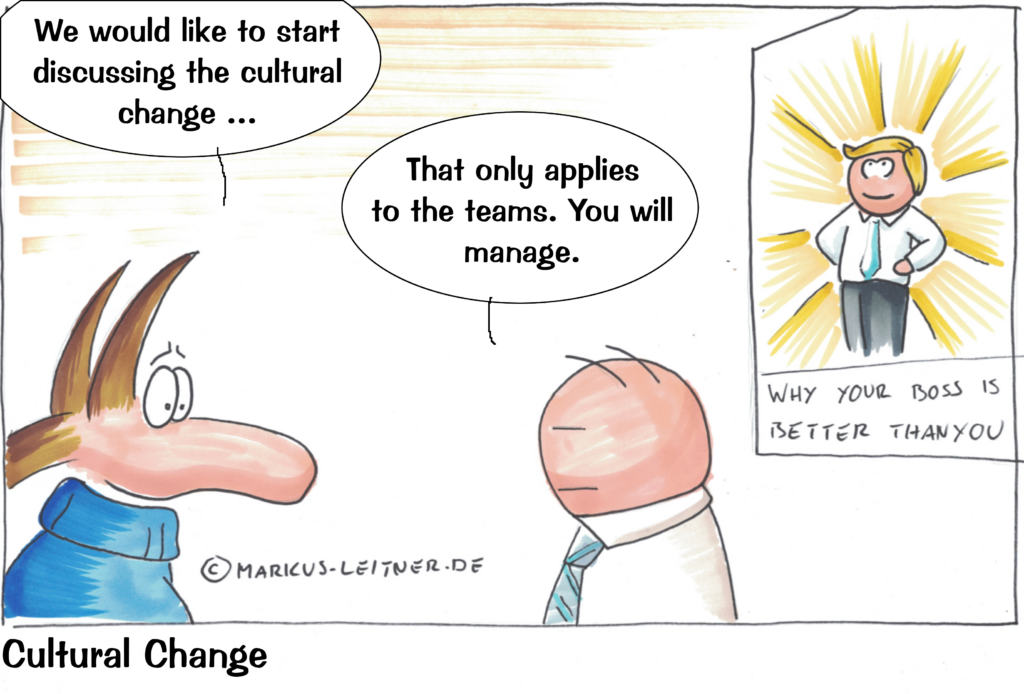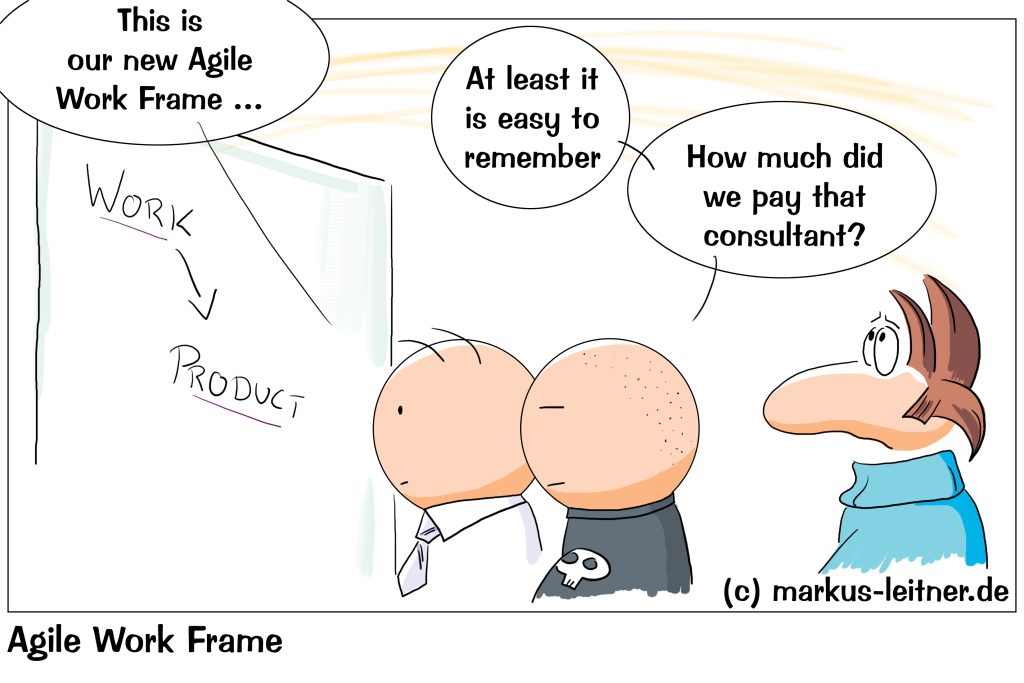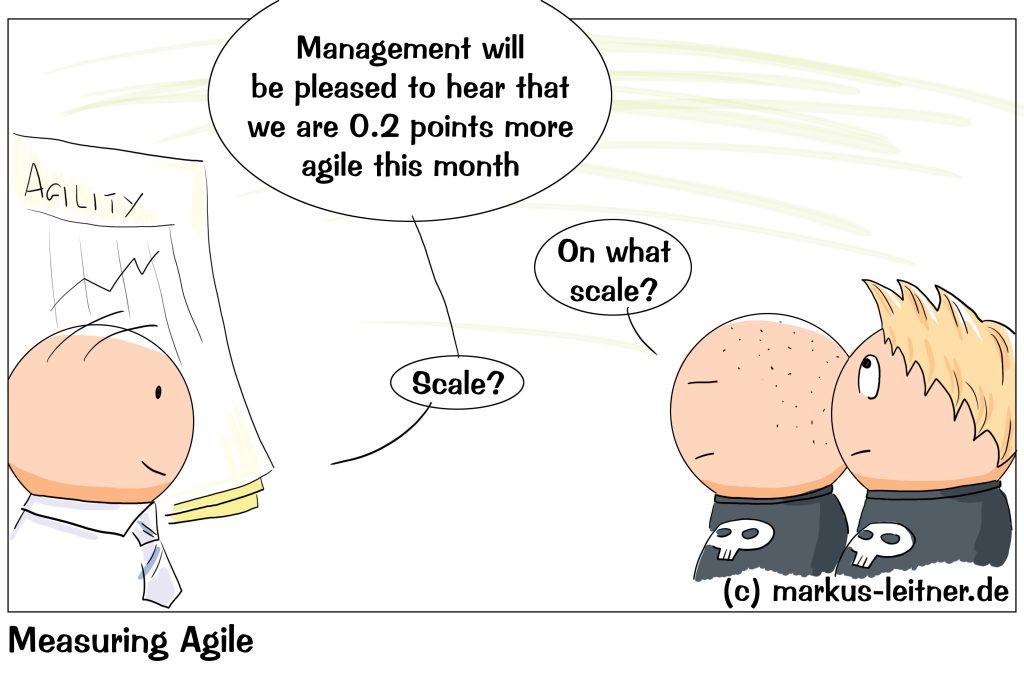
When agility in a company fails, it is often because we have tried to look at it in isolation. We have more talked about a method than the principle. And when we talk about the principle of agile, we are deeply immersed in cultural topics – whether we want it or not.
Let us look at what happens mostly: An organization comes to the conclusion, that all the happiness of the world and the key to success lies within agile methods. Therefore it buys a Jira license and introduces Scrum on team level. All teams should now be self organized and follow the Scrum events.
And somehow everyone lives happily ever after.
OK, that might have been a little overly simplified. There are some intelligent people in your companies, thinking about problems and solutions. But discussion is mostly about actions and consequences, not about conditions. If we ignore those, problems rise.
Thoughts about agility mostly start at the things we hope to achieve. No problem so far. After all, the whole thing is not an end in itself.
But now things start to become difficult: Sometimes (or better: most of the time) we are presented with a method in the hope that using those would bring us beneficial consequences. But a method like Scrum is only help and assistance in living the agile principle. We have to know that, we have to understand that, and we have to be aware of that all of the time. After all, it is not about slavishly sticking to a certain series of events, but about living the control loop of Plan-Do-Check-Act, of continuous learning from experience, in a stable manner. The series of appointments give by scrum is just support for that.
If we ask about learning by experience (and feedback), we should also ask, what we need to do so, and that last question is something we too often ignore.
Feedback needs an open communication, free from fear and hierarchy and stuff like that. If we do not have that, we won’t get proper and useful feedback. If we do not get proper and useful feedback. Without feedback – no learning. Without learning we achieve ethe square root of nothing. Without learning we do not get the positive consequences we hope for.
Another example? Self-organization only works, if all can talk at eye level. That also needs lots of initiative and discipline (that is a bad word – I know). Let us not forget, that we do not do all that agile stuff, because we like each other so much. We want to achieve something, and no one has ever achieved anything without kicking themselves in the ass.
Therefore, at any discussion about agility in our organizations we are deep in cultural basic topics. If we are in an environment, characterized by deep distrust in our communication, there is little to no point in talking about agility, if do not also talk about cultural change.
Now there are wo options: we could hope, that the introduction of agile methods automatically brings all the needed cultural basic work with them, and that we do not have to address them separately, or we could make culture consciously our topic, which I would advise you to do in any case.
Do we have to wait for cultural change, before we can start with our agile offensive?
No. Cultural change is time consuming and tough. That takes years and even more years. We do not have the patience, we can not have the patience. Our wish for change through agility does nt come by itself. It is fed, because there is a problem, and if that problem could wait for three years, it would not be a problem.
Having that strong cultural component means, that this stuff is not so easy as imagined, and that hoped for consequences won’t come that fast. You can read everywhere, that a teams will need two or three sprints to get used to the new methods. After that it would be steep climb. But if we have communication issues, a topic with discipline or whatever, things will not go so fast. Then introduction of agile methods will be tough and take lots of time.
Do not trust anyone, who promises you any results (especially not any time frames) without knowing your organization.
If we have a problem in our company, that we try to solve with the aid of agility, we also have cultural topics. If we are lucky, we do not have to talk about cultural change. Maybe we are well positioned, but we have to find out. We have to know, where we are, and what we have to talk about, what issues to address. For starters, we should focus on communication, initiative, discipline and hierarchy.
If we have a healthy and trusting open communication, we have a good base for healthy feedback. Initiative and discipline are base topics for self-organization. Too much hierarchy on the other hand will crush just everything, because we need to talk at eye level. Otherwise we could just stick to the principle of external control by the superior.
We also have to address our error culture somewhere in time. Just a small hint: »error culture« does not necessary mean, that we have a forgiving error culture. The expression does not say anything about its content. It only means, that there is a consistent and defined handling of errors. How that looks in detail, we have to decide ourselves.
So we have a lot of cultural topics to deal with. If we look closely at our organizations, we may find, that we are presented with the whole scale from horrible to OK. How could it be otherwise? Would be too nice, if things could be easy for a change.
For us, this means that we have to address cultural issues with our agile methods in good time. And next time we will take a closer look at how to initiate a cultural change. Because there can be done a lot of nonsense.
Core: Agility needs an environment, where certain cultural base topics are addressed. That includes open communication, initiative, discipline and hierarchy.
If you need any assistance or want to know more, just speak to me.











